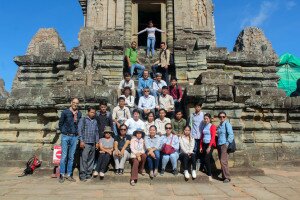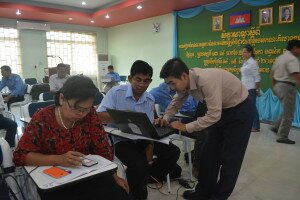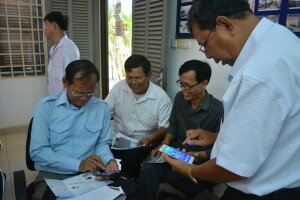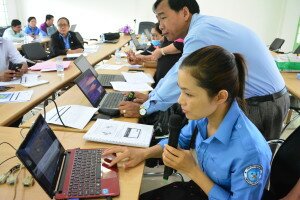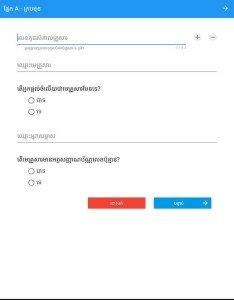Introduction to Traditional Cambodian Lacquer

Master lacquerer (Eric Stocker) explaining the different layers required during application of natural lacquer.
08 August 2018
Amongst their continuous conservation and restoration efforts in the Angkor Park, the APSARA Stone Conservation Unit (SCU) is currently working on two prestigious late 12th-century Buddha statues at Prasat Pre Rup (as previously mentioned here). Both statues are, as one would expect, typically covered in various coats and layers of natural lacquer and polychromy, including decorative embellishments and faint traces of gold leaf. In order to successfully carry out any conservation measures to the highest possible standards the topic of historic lacquer conservation needs to be explored further before starting any actual work on this material.
One first step to address this topic adequately has been taken recently in form of a one-day training workshop. On July 5th, 2018 thirty professionals in the field of stone conservation and archaeology from the APSARA Authority as well as the Angkor Conservation Office have been introduced to traditional Cambodian lacquer and its application during an interactive workshop session organised in cooperation between the APSARA Authority and GIZ.
The workshop featured three distinct forms of engagement, starting with a site visit at Prasat Pre Rup to introduce the subject directly at the Buddha statues themselves which enabled all participants to identify a variety of historic lacquer applications as well as developing a better understanding of the context of its utilisation in the past. This was followed by a lecture in the Angkor Training Centre of the APSARA Authority on the history and traditional harvesting and processing methods as well as the common uses of the material in Southeast Asia in which the consultant provided not only theoretical aspects on the topic but also has been available for an extensive question and answer session to clarify any concerns by the participants. Building upon all the acquired conceptual knowledge during the first two sessions, the workshop concluded with its main session focussing solely on the practical methods of application for the remainder of the day. Here the attendees could develop hands-on skills in treating their individual stone sample pieces with traditional natural lacquer techniques following the strict methodological guidance by the consultant in its layered application.
D
We are happy to have been able to engage with Mr Eric Stocker one of the most prominent experts on traditional Cambodian lacquer in the country for this workshop. With his background in professional conservation of historic Southeast Asian lacquer work in French museums he came to Cambodia to re-stablish the traditional use of local natural lacquer 20 years ago. He has since successfully trained numerous locals in these precious skills and continues to do so in his own workshop in Siem Reap to this day.
However, both local lacquer trees as well as its traditional utilisation are in steep decline in modern Cambodia and, unfortunately, with it the skills and knowledge surrounding its harvest, processing and application. For conserving the precious historic Buddha statues at Prasat Pre Rup, as anywhere in the Kingdom, only to the highest professional standards should be applied. This provides an excellent opportunity to respond to the needs of meaningful capacity building for local professionals so that they are not only enabled to best care for their highly valued tangible heritage objects and monuments but also can contribute to the preservation of intangible heritage like traditional skills and capabilities.
Nurse Online Registration Management System
06 July 2018
March, April and June, 2018
Siem Reap and 10 selected provinces, Cambodia
All Cambodian nurses who exercise as medical professional assistants must register with the Cambodian Council of Nurses (CCN). In order to ease the feasibility of the registration to all nurses everywhere in the country, the online registration system was developed and launched in late March 2018. More >>>
Nurse Online Registration Management System
06 July 2018
March, April and June, 2018
Siem Reap and 10 selected provinces, Cambodia
All Cambodian nurses who exercise as medical professional assistants must register with the Cambodian Council of Nurses (CCN). In order to ease the feasibility of the registration to all nurses everywhere in the country, the online registration system was developed and launched in late March 2018.
To make the new online registration system work smoothly and successfully, the CCN organized a Training of Trainers (ToT) on the Online Registration Management System on March 15, 2018 in Siem Reap province. Around 50 participants from all regional and provincial heads of the council participated to become ToT for the sub-national trainings that would be organized later.
With the intention of improving the quality of the health care services and ensure that the safety of all Cambodians receiving these health care services, the Ministry of Health (MoH) released a new law on Regulation of Health Practitioners in late 2016. This new law allows the CCN to effectively regulate their profession. The CCN wants to make sure that all nurses have the necessary qualifications and are competent to practice their profession and are easily identifiable by everyone: patients, the community, employers and education providers.
The registration as a health professional is a basic step to start a nursing career and it’s for life; being registered means that the Council acknowledges a person as being technically trained and holding a qualification recognized by the MoH. It also means that the individual has no mental or physical health condition that will impair his/her professional practice and no criminal conviction in Cambodia or other countries. Once registered with their respective Councils, they are known as health professionals and can use the title of Doctor, Dentist, Midwife, Nurse or Pharmacist. Furthermore, to legally practice their nursing profession, nurses need to apply for a license to practice; otherwise, they are not allowed to exercise their nursing profession. Besides the national registration, in the near future, Cambodian nurses will be able to register regionally in order to work in the ASEAN Member States-AMS (ASEAN region) through the ASEAN Mutual Recognition Arrangement (ASEAN MRA-NS) and globally.
GIZ, the main development partner, strongly stressed out on how important the registration is and the role of nursing regulatory authority-CCN. Ministry of Health, CCN and GIZ are jointly working on ASEAN MRA-NS, which aims at enhancing work force skills, qualifications and service delivery and at promoting the mobility of skilled labour in the future.
To quickly promote this new online registration system to ordinary nurses in all the provinces, especially the provinces with low rate of registered nurses, the CCN with technical and financial support from GIZ, organized sub-national trainings to all the Lead Nurses in ten selected provinces namely Pursat, Battambang, Banteay Meanchey, Udor Meanchey, Kampong Speu, Koh Kong, Kampong Cham, Kampong Thom, Preah Vihear and Steung Treng, in April and June 2018. The ToT in each of the mentioned provinces successfully provided the trainings with the strong technical support of a GIZ advisor to ensure smooth and clear instructions. By the end of the trainings, all of those Lead Nurses were able to disseminate the information and train ordinary nurses in their work place, making them aware of the new system and able to use the system by themselves, since it helps them to save both time and money.
The follow-up sessions will be done in the next three months in those selected provinces to see the progress of nurse registrations compared to the status before the trainings were provided.
aimer
ASEAN-German Cooperation Project “Support to the Initiative for ASEAN Integration (IAI)” supports implementing ASEAN agreements including Mutual Recognition Arrangements (MRAs). The project operates in Cambodia, Lao PDR, Myanmar and Viet Nam until November 2018.
For more information, please contact GIZ IAI Senior Advisor Ms. Kamrang Ke ([email protected])
aimer
How digital solutions facilitate the identification of poor households in Cambodia
When poverty hits, people struggle to even afford their basic needs. Getting nutritious food and clean drinking water can be a challenge, compromises on education might have to be made. It can be devastating, especially when one encounters health issues.
To tackle poverty and identify those in need for support the Cambodian government with the support of its partners, Germany and Australia, implements a unique solution: IDPoor. …
How digital solutions facilitate the identification of poor households in Cambodia
When poverty hits, people struggle to even afford their basic needs. Getting nutritious food and clean drinking water can be a challenge, compromises on education might have to be made. It can be devastating, especially when one encounters health issues.
To tackle poverty and identify those in need for support the Cambodian government with the support of its partners, Germany and Australia, implements a unique solution: IDPoor.
aimer
IDPoor aims to reduce poverty
Since 2006, the Ministry of Planning (MoP) of the Royal Government of Cambodia implements a poverty identification mechanism called Identification of Poor Households (IDPoor). It is part of the Royal Government of Cambodia’s ongoing efforts to reduce poverty and support socio-economic development throughout the country. IDPoor uses a hybrid model to combine the objectivity of a proxy means test survey with the accuracy and affordability of a community-based selection process. The programme provides regularly updated information on poor households to many governmental and non-governmental agencies to help them target services and assistance to the poorest and most vulnerable households.
The implementation of the regular IDPoor process requires substantial human, financial and time resources to which the current government capacity is not able to accommodate. For this reason, the government is only able to reach eight provinces per year in the regular IDPoor process, causing a three-year waiting period before the same province is reassessed. For eligible families who were either absent or not identified in their respective round, or families falling into poverty in between rounds, the waiting period for the next IDPoor round can be too long.
A new on-demand identification process and use of new technologies help reaching even more poor households
As a response to these concerns, the MoP with support from GIZ has developed an On Demand Identification Mechanism (OD-IDPoor) to assess families that could not be identified during the regular identification process. The OD-IDPoor mechanism is triggered on-demand by the local level and intends to make IDPoor more dynamic and flexible.
MoP is carrying out a pilot over a period of 12 months (01/2018 – 01/2019) in the three target provinces: Tboung Khmum, Ratanakiri and Battambang.
OD-IDPoor makes use of innovative technological solutions: A digital tool allows local implementers at commune level to manage new requests, carry out interviews to determine the poverty status and print out IDPoor cards using a tablet. Data is automatically transferred to the National IDPoor database. The application has been designed for users with low IT literacy. The potential advantages are compelling: Using smart devices for data collection not only makes the process faster and more flexible but might also improve quality of data and save costs. Entering questionnaire data directly into a device makes data immediately available, saving time and costs of data entry and printing paper forms. Error messages, skip logic, and automatic score calculations simplify the process and reduce errors. Assessing these assumptions and the ability of local implementers to use these new technologies is part of the pilot implementation. Since the IDPoor process is community-driven, there was concern that if key steps in the IDPoor process require digital skills of local implementers, this might limit the participation of a significant portion of villagers. Hence, the merits of ‘quick and digital’ should not necessarily be prioritised over the value of ‘inclusive and participatory’ – IDPoor strives for a combination of both in order to maximise benefit and minimise error and cost, in line with government and community priorities.
The IDPoor Programme is supported by the German Federal Ministry for Economic Cooperation and Development (BMZ) and the Australian Department of Foreign Affairs and Trade (DFAT), implemented by Deutsche Gesellschaft für Internationale Zusammenarbeit (GIZ) GmbH. The development of the OD-IDPoor App was supported by Save the Children Cambodia on behalf of United States Agency for International Development (USAID) and UNICEF.
– by GIZ IDPoor
aimer


